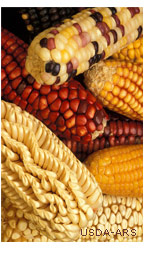Introduction to Genetic Modification
Comparing classical breeding to genetic engineering
Classical breeding
 Farmers have been doing genetic modification of crops for at least 10,000 years by selecting plants with desirable traits (characteristics). In traditional plant breeding, new varieties are developed either by selecting plants with desirable characteristics or by combining qualities from two closely related plants. These features may be resistance to a particular pest or disease, or tolerance to climatic conditions. Pollen which contains the genes for a desired trait is transferred from one related crop variety to another. Eventually, the desired trait will appear in a new family of plants.
Farmers have been doing genetic modification of crops for at least 10,000 years by selecting plants with desirable traits (characteristics). In traditional plant breeding, new varieties are developed either by selecting plants with desirable characteristics or by combining qualities from two closely related plants. These features may be resistance to a particular pest or disease, or tolerance to climatic conditions. Pollen which contains the genes for a desired trait is transferred from one related crop variety to another. Eventually, the desired trait will appear in a new family of plants.
In traditional breeding, crosses are made in a relatively uncontrolled manner. The breeder chooses the parents to cross, but at the genetic level, the results are unpredictable. DNA from the parents recombines randomly, and desirable traits such as pest resistance may be bundled with undesirable traits, such as lower yield or poor quality. The parent plants must be closely related to produce offspring.Traditional breeding programs are time-consuming and labor-intensive. A great deal of effort is required to separate undesirable from desirable traits, and this is not always economically practical. Many potential benefits are lost along the way, as plants that fail to demonstrate the introduced characteristics are discarded. Traditional plant breeding takes on average 12-15 years to produce a new variety.
Classical breeding with induced mutation
 Mutations are changes in the genetic sequence of a plant. Mutations occur naturally and sometimes result in beneficial traits. Plant breeders use chemicals and irradiation to induce mutations more frequently than would happen naturally. The breeder then has more variation to select from. Over 2,500 plant varieties have been developed using radiation mutagenesis (FAO/IAEA, 2008). Of these, about half are food crops.
Mutations are changes in the genetic sequence of a plant. Mutations occur naturally and sometimes result in beneficial traits. Plant breeders use chemicals and irradiation to induce mutations more frequently than would happen naturally. The breeder then has more variation to select from. Over 2,500 plant varieties have been developed using radiation mutagenesis (FAO/IAEA, 2008). Of these, about half are food crops.
Genetic engineering
In the 1970s, advances in the field of molecular biology provided scientists with the ability to readily transfer DNA between more distantly related organisms. DNA is essentially the same in all living things - different characteristics are determined by the sequence of the base pairs. (See these sites for a decription of DNA: NIH What is DNA?, University of Utah What is DNA?) Biotechnology has reached a stage where scientists can take one or more specific genes from nearly any organism, including plants, animals, bacteria, or viruses, and introduce those genes into another organism.
 Agricultural biotechnology changes are made directly to the plant's genome. Once the code of a gene that determines a desirable trait is identified, it can be selected and transferred directly into another plant genome. Plants that have genes from other organisms are referred to as transgenic.
Agricultural biotechnology changes are made directly to the plant's genome. Once the code of a gene that determines a desirable trait is identified, it can be selected and transferred directly into another plant genome. Plants that have genes from other organisms are referred to as transgenic.
The presence of the desired gene, controlling the trait, can be tested for at any stage of growth, such as in small seedlings in a greenhouse tray. A breeder evaluates the plants that are produced and selects the plants that best express the desired trait. Producing crops through genetic engineering takes about 10 years. It takes time to identify the gene for the desired trait and once the plant is produced extensive testing is done before the crop is released for public consumption.

